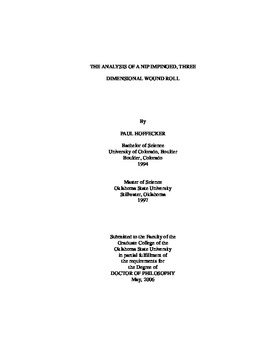| dc.contributor.advisor | Good, J. K. | |
| dc.contributor.author | Hoffecker, Paul | |
| dc.date.accessioned | 2013-12-10T18:05:16Z | |
| dc.date.available | 2013-12-10T18:05:16Z | |
| dc.date.issued | 2006-05 | |
| dc.identifier.uri | https://hdl.handle.net/11244/7796 | |
| dc.description.abstract | Scope and Method of Study: An accurate, nip impinged, three dimensional wound roll model can improve the quality of numerous consumer products. This is because the products use webs that were once wound into a roll. The model identifies potentially destructive stress levels without actually winding, thereby reducing waste, and boosting efficiency. To this end, it integrates a three dimensional roll sub-model, with a peripheral nip contact sub-model, in a recursive exchange. The three dimensional sub-model is an orthotropic, axisymmetric-quadrilateral finite element model that accretes by interfering layers onto each other. It incorporates thickness variations in the web profile in the CMD, variable core configurations, and wound on tension iteration. The peripheral nip sub-model is a linked system of beam finite elements. A winkler elastic foundation, with a non-linear radial stiffness, represents the wound roll, which is radiatively coupled to both the impinging nip, and the core. Control passes back and forth between the submodels as each contributes to the final nip impinged, three dimensional roll. | |
| dc.description.abstract | Findings and Conclusions: The combined model is a significant step forward in wound roll simulations. The underlying axisymmetric sub-model is one of the most extensive, and accurate, known to exist. Its CMD radii, and stresses, compared well to experimental data. It captured the tension concentration, and radius buildup, recognized to correspond with thicker CMD locations. When combined with the nip sub-model, the result is the first, and only, model known to also incorporate the CMD compression, and load distribution, effects of nip impingement. Its results show the nip load concentrates at higher locations to reduce their radii. And, its comparison to the 14 pound, six inch wide PET web experimental data was good. Ultimately, the combined model promises versatility, and utility, in its application to improve the quality of wound rolls in industry. | |
| dc.format | application/pdf | |
| dc.language | en_US | |
| dc.rights | Copyright is held by the author who has granted the Oklahoma State University Library the non-exclusive right to share this material in its institutional repository. Contact Digital Library Services at lib-dls@okstate.edu or 405-744-9161 for the permission policy on the use, reproduction or distribution of this material. | |
| dc.title | Analysis of a nip impinged, three-dimensional wound roll | |
| dc.contributor.committeeMember | Gipson, G. Steven | |
| dc.contributor.committeeMember | Lu, Hongbing | |
| dc.contributor.committeeMember | Price, C. E. | |
| osu.filename | Hoffecker_okstate_0664D_1716.pdf | |
| osu.accesstype | Open Access | |
| dc.type.genre | Dissertation | |
| dc.type.material | Text | |
| thesis.degree.discipline | Mechanical and Aerospace Engineering | |
| thesis.degree.grantor | Oklahoma State University | |
